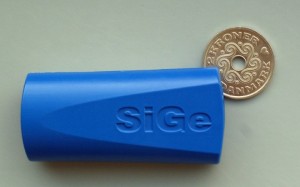A USB GNSS radio front-end (designed by Dennis Akos) is available and it is matched to the GNSS SDR book. Since the publication time of book there were several iterations of the front-end versions. The front-end does not come with the book, but instead can be bought on an online electronics store (Sparkfun). Please visit the homepage of the front-end for more details and the original USB drivers at ccar.colorado.edu/gnss/.
There are also front-ends from other manufactures, which will work with our SDR, but in some cases the SDR code must by modified. For example a few versions of such GNSS front-ends are manufactured by Nottingham Scientific Limited (a custom front-end version by NSL is shown in the picture at the top of this page). These front-ends are based on a very flexible GNSS front-end chip from Maxim. In addition these front-end employ a hardware data packing which reduces the USB data rate from 16MB/s to 4MB/s.
A much bigger, but also a much more versatile SDR front-end is the USRP universal front-end which is used by the GNU radio project.
Other examples are wideband front-ends for professional applications like the one from Fraunhofer IIS that can be also connected using USB or other interfaces.
DGC’s Alternative Driver for the Front-end from Dennis Akos
Note this section is here for support of legacy code and hardware. This driver was designed and tested to work with the first version of the front-end!
The Danish GPS Center has developed an alternative driver for this front-end. The driver was tested only on Windows XP and only using the first version of the front-end.
Update! Application code was updated on 04/02/2011 to fix a bug (internal data corruption). Download.
The Danish GPS Center recorder application or driver do not have any inbuilt record length limitations. The longer the signal records are the higher is chance that the PC might not be able to keep up writing data to the hard disk. The recorder application might report this kind of error: “ERROR! Buffer overrun in the GNSS Front-end! Recording stopped.”. It means that the PC could not keep up with the incoming data from the front-end. Usually the processor speed is not the crucial factor here. The most important is the speed of the hard disk. Disk speed depends on several factors, but the most important are its file fragmentation, disk technology, speed (in particular notebook disks used to be slow). Also note that the disk speed is reduced when the disk is nearly full. In addition Windows services can interfere with the recording process by performing their own reading/writing operations which will further reduce the disk writing speed.
How to Import USB Recorder Code into Microsoft Visual Studio
Here are instructions how to import the recording application source code into Microsoft Visual Studio 2005.
- In Visual Studio select menu item: “File”->”New”->”Project From Existing Code…”
- In the wizard window set project type to “Visual C++” and click “Next”
-
- Field “Project file location:” must contain full path to the source code of the application (e.g. the code that is contained in folder “app source code”)
- Enter some name for the project
- Click “Next”
-
- Make sure “Use Visual studio” option is selected
- Change “Project Type:” to “Console application project”
- Make sure that none of the other options are selected
- Click “Finish” (the rest of the options in the wizard do not have to be changed)
After this you should be able to build (compile) the VC project.


Hello
I have a SiGe GN3S GPS sampler version 1.
What kind of the antenna I can use for this front end, active antenna or passive antenna. I read the datasheet of SE4110L. It supported bother active antenna and passive antenna. However, when I connect it to an active antenna, it could not work? Does the LNA in the front end is disabled or not?
thanks a lot
Hello,
It is the best to ask this question the front-end designers.
My quick answer would be that this front-end should be able to support both types of antennas, but the passive antenna may give a very low SNR in the sampled signal. This may require more sensitive acquisition and tracking algorithms.
In the case of the active antenna please make sure that the antenna phantom power voltage is the same as the voltage provided by the front-end. I am not 100%, but I think the different front-end version can have 5V or 3.3V phantom power output for the antenna. For some active antennas this may be a too low voltage. Check specifications/documentation of the antenna and the front-end.
We have a problem in finding the SiGe GN3S Sampler front end in any company to use it with the course material. Do you have any suggestions? Can we use alternative front ends? If yes, what changes should be done in the MATLAB codes?
Hello,
I only know that a new version of this front-end was in development, but I do not know its current status. I cannot help you further with front-ens. We have a bit of info about other front-ends on our homepage, but it is the best to search on the Internet for GNSS front-ends that suite your needs. Please be aware that you must have software that can record the signal from the front-end to a record (file).
Our software is not locked to a specific front-end because it is processing signals from the record files. You will need to adapt the receiver settings to match the properties of the signal record. If the signal is sampled using quadrature sampling (I and Q samples) and not as a real signal, then you will need to do the same receiver modifications as in the case of the SiGe GN3S Sampler. The code changes are published on the front-end’s homepage.